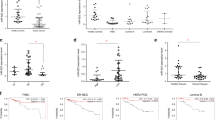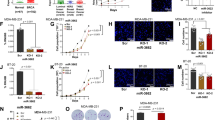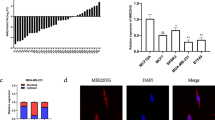Abstract
Micro RNAs are small non-coding RNAs, which regulate fundamental cellular and developmental processes at the transcriptional and translational level. In breast cancer, miR-145 expression is downregulated compared with healthy control tissue. As several predicted targets of miR-145 potentially regulate cell motility, we aimed at investigating a potential role for miR-145 in breast cancer cell motility and invasiveness. Assisted by Affymetrix array technology, we demonstrate that overexpression of miR-145 in MDA-MB-231, MCF-7, MDA-MB-468 and SK-BR-3 breast cancer cells and in Ishikawa endometrial carcinoma cells leads to a downregulation of the cell–cell adhesion protein JAM-A and of the actin bundling protein fascin. Moreover, podocalyxin and Serpin E1 mRNA levels were downregulated, and gamma-actin, transgelin and MYL9 were upregulated upon miR-145 overexpression. These miR-145-dependent expression changes drastically decreased cancer cell motility, as revealed by time-lapse video microscopy, scratch wound closure assays and matrigel invasion assays. Immunofluorescence microscopy demonstrated restructuring of the actin cytoskeleton and a change in cell morphology by miR-145 overexpression, resulting in a more cortical actin distribution, and reduced actin stress fiber and filopodia formation. Nuclear rotation was observed in 10% of the pre-miR-145 transfected MDA-MB-231 cells, accompanied by a reduction of perinuclear actin. Luciferase activation assays confirmed direct miR-145-dependent regulation of the 3′UTR of JAM-A, whereas siRNA-mediated knockdown of JAM-A expression resulted in decreased motility and invasiveness of MDA-MB-231 and MCF-7 breast cancer cells. Our data identify JAM-A and fascin as novel targets of miR-145, firmly establishing a role for miR-145 in modulating breast cancer cell motility. Our data provide a rationale for future miR-145-targeted approaches of antimetastatic cancer therapy.
This is a preview of subscription content, access via your institution
Access options
Subscribe to this journal
Receive 50 print issues and online access
$259.00 per year
only $5.18 per issue
Buy this article
- Purchase on Springer Link
- Instant access to full article PDF
Prices may be subject to local taxes which are calculated during checkout






Similar content being viewed by others
Accession codes
References
Baehrecke EH . (2003). miRNAs: micro managers of programmed cell death. Curr Biol 13: R473–R475.
Bartel DP . (2004). MicroRNAs: genomics, biogenesis, mechanism, and function. Cell 116: 281–297.
Cera MR, Fabbri M, Molendini C, Corada M, Orsenigo F, Rehberg M et al. (2009). JAM-A promotes neutrophil chemotaxis by controlling integrin internalization and recycling. J Cell Sci 122: 268–277.
Cheng Y, Liu X, Yang J, Lin Y, Xu DZ, Lu Q et al. (2009). MicroRNA-145, a novel smooth muscle cell phenotypic marker and modulator, controls vascular neointimal lesion formation. Circ Res 105: 158–166.
Chiyomaru T, Enokida H, Tatarano S, Kawahara K, Uchida Y, Nishiyama K et al. (2010). miR-145 and miR-133a function as tumour suppressors and directly regulate FSCN1 expression in bladder cancer. Br J Cancer 102: 883–891.
Cordes KR, Sheehy NT, White MP, Berry EC, Morton SU, Muth AN et al. (2009). miR-145 and miR-143 regulate smooth muscle cell fate and plasticity. Nature 460: 705–710.
Darnel AD, Behmoaram E, Vollmer RT, Corcos J, Bijian K, Sircar K et al. (2009). Fascin regulates prostate cancer cell invasion and is associated with metastasis and biochemical failure in prostate cancer. Clin Cancer Res 15: 1376–1383.
Ebnet K, Suzuki A, Horikoshi Y, Hirose T, Meyer Zu Brickwedde MK, Ohno S et al. (2001). The cell polarity protein ASIP/PAR-3 directly associates with junctional adhesion molecule (JAM). EMBO J 20: 3738–3748.
Ebnet K, Suzuki A, Ohno S, Vestweber D . (2004). Junctional adhesion molecules (JAMs): more molecules with dual functions? J Cell Sci 117: 19–29.
Elmén J, Lindow M, Schutz S, Lawrence M, Petri A, Obad S et al. (2008). LNA-mediated microRNA silencing in non-human primates. Nature 452: 896–899.
Gerashchenko MV, Chernoivanenko IS, Moldaver MV, Minin AA . (2009). Dynein is a motor for nuclear rotation while vimentin IFs is a ‘brake’. Cell Biol Int 33: 1057–1064.
Gomes ER, Jani S, Gundersen GG . (2005). Nuclear movement regulated by Cdc42, MRCK, myosin, and actin flow establishes MTOC polarization in migrating cells. Cell 121: 451–463.
Götte M . (2010). Endometrial cells get side-tracked: side population cells promote epithelial-mesenchymal transition in endometrial carcinoma. Am J Pathol 176: 25–28.
Götte M, Spillmann D, Yip GW, Versteeg E, Echtermeyer FG, van Kuppevelt TH et al. (2008). Changes in heparan sulfate are associated with delayed wound repair, altered cell migration, adhesion and contractility in the galactosyltransferase I (beta4GalT-7) deficient form of Ehlers-Danlos syndrome. Hum Mol Genet 17: 996–1009.
Griffiths-Jones S, Grocock RJ, van Dongen S, Bateman A, Enright AJ . (2006). miRBase: microRNA sequences, targets and gene nomenclature. Nucleic Acids Res 34: D140–D144.
Hashimoto Y, Parsons M, Adams JC . (2007). Dual actin-bundling and protein kinase C-binding activities of fascin regulate carcinoma cell migration downstream of Rac and contribute to metastasis. Mol Biol Cell 18: 4591–4602.
Hutvagner G, McLachlan J, Pasquinelli AE, Balint E, Tuschl T, Zamore PD . (2001). A cellular function for the RNA-interference enzyme Dicer in the maturation of the let-7 small temporal RNA. Science 293: 834–838.
Iorio MV, Ferracin M, Liu CG, Veronese A, Spizzo R, Sabbioni S et al. (2005). MicroRNA gene expression deregulation in human breast cancer. Cancer Res 65: 7065–7070.
Ishiwata I, Ishiwata C, Soma M, Arai J, Ishikawa H . (1984). Establishment of human endometrial adenocarcinoma cell line containing estradiol-17 beta and progesterone receptors. Gynecol Oncol 17: 281–290.
Kano M, Seki N, Kikkawa N, Fujimura L, Hoshino I, Akutsu Y et al. (2010). miR-145, miR-133a and miR-133b: Tumor suppressive miRNAs target FSCN1 in esophageal squamous cell carcinoma. Int J Cancer (in press; PMID: 20198616; doi:10.1002/ijc.25284).
Kim MY, Oskarsson T, Acharyya S, Nguyen DX, Zhang XH, Norton L et al. (2009a). Tumor self-seeding by circulating cancer cells. Cell 139: 1315–1326.
Kim SJ, Choi IJ, Cheong TC, Lee SJ, Lotan R, Park SH et al. (2009b). Galectin-3 increases gastric cancer cell motility by up-regulating fascin-1 expression. Gastroenterology 138: 1035–1045. e1–2.
Lacroix M, Leclercq G . (2004). Relevance of breast cancer cell lines as models for breast tumours: an update. Breast Cancer Res Treat 83: 249–289.
Larrucea S, Butta N, Arias-Salgado EG, Alonso-Martin S, Ayuso MS, Parrilla R . (2008). Expression of podocalyxin enhances the adherence, migration, and intercellular communication of cells. Exp Cell Res 314: 2004–2015.
Larsson E, Fredlund FP, Heldin J, Barkefors I, Bondjers C, Genove G et al. (2009). Discovery of microvascular miRNAs using public gene expression data: miR-145 is expressed in pericytes and is a regulator of Fli1. Genome Med 1: 108.
Lee Y, Ahn C, Han J, Choi H, Kim J, Yim J et al. (2003). The nuclear RNase III Drosha initiates microRNA processing. Nature 425: 415–419.
Levy JR, Holzbaur EL . (2008). Dynein drives nuclear rotation during forward progression of motile fibroblasts. J Cell Sci 121: 3187–3195.
Liu X, Sempere LF, Galimberti F, Freemantle SJ, Black C, Dragnev KH et al. (2009). Uncovering growth-suppressive MicroRNAs in lung cancer. Clin Cancer Res 15: 1177–1183.
Ma L, Teruya-Feldstein J, Weinberg RA . (2007). Tumour invasion and metastasis initiated by microRNA-10b in breast cancer. Nature 449: 682–688.
McSherry EA, McGee SF, Jirstrom K, Doyle EM, Brennan DJ, Landberg G et al. (2009). JAM-A expression positively correlates with poor prognosis in breast cancer patients. Int J Cancer 125: 1343–1351.
Megraw M, Sethupathy P, Corda B, Hatzigeorgiou AG . (2007). miRGen: a database for the study of animal microRNA genomic organization and function. Nucleic Acids Res 35: D149–D155.
Naik MU, Naik TU, Suckow AT, Duncan MK, Naik UP . (2008). Attenuation of junctional adhesion molecule-A is a contributing factor for breast cancer cell invasion. Cancer Res 68: 2194–2203.
Naik MU, Vuppalanchi D, Naik UP . (2003). Essential role of junctional adhesion molecule-1 in basic fibroblast growth factor-induced endothelial cell migration. Arterioscler Thromb Vasc Biol 23: 2165–2171.
Nikolova V, Koo CY, Ibrahim SA, Wang Z, Spillmann D, Dreier R et al. (2009). Differential roles for membrane-bound and soluble syndecan-1 (CD138) in breast cancer progression. Carcinogenesis 30: 397–407.
Ostenfeld MS, Bramsen JB, Lamy P, Villadsen SB, Fristrup N, Sørensen KD et al. (2010). miR-145 induces caspase-dependent and -independent cell death in urothelial cancer cell lines with targeting of an expression signature present in Ta bladder tumors. Oncogene 29: 1073–1084.
Qualtrough D, Singh K, Banu N, Paraskeva C, Pignatelli M . (2009). The actin-bundling protein fascin is overexpressed in colorectal adenomas and promotes motility in adenoma cells in vitro. Br J Cancer 101: 1124–1129.
Quintavalle M, Elia L, Condorelli G, Courtneidge SA . (2010). MicroRNA control of podosome formation in vascular smooth muscle cells in vivo and in vitro. J Cell Biol 189: 13–22.
Sachdeva M, Mo YY . (2010). MicroRNA-145 suppresses cell invasion and metastasis by directly targeting mucin 1. Cancer Res 70: 378–387.
Sachdeva M, Zhu S, Wu F, Wu H, Walia V, Kumar S et al. (2009). p53 represses c-Myc through induction of the tumor suppressor miR-145. Proc Natl Acad Sci USA 106: 3207–3212.
Seidler DG, Faiyaz-Ul-Haque M, Hansen U, Yip GW, Zaidi SH, Teebi AS et al. (2006). Defective glycosylation of decorin and biglycan, altered collagen structure, and abnormal phenotype of the skin fibroblasts of an Ehlers-Danlos syndrome patient carrying the novel Arg270Cys substitution in galactosyltransferase I (beta4GalT-7). J Mol Med 84: 583–594.
Sempere LF, Christensen M, Silahtaroglu A, Bak M, Heath CV, Schwartz G et al. (2007). Altered MicroRNA expression confined to specific epithelial cell subpopulations in breast cancer. Cancer Res 67: 11612–11620.
Sempere LF, Liu X, Dmitrovsky E . (2009). Tumor-suppressive microRNAs in Lung cancer: diagnostic and therapeutic opportunities. ScientificWorldJournal 9: 626–628.
Severson EA, Lee WY, Capaldo CT, Nusrat A, Parkos CA . (2009). Junctional adhesion molecule A interacts with Afadin and PDZ-GEF2 to activate Rap1A, regulate beta1 integrin levels, and enhance cell migration. Mol Biol Cell 20: 1916–1925.
Sizemore S, Cicek M, Sizemore N, Ng KP, Casey G . (2007). Podocalyxin increases the aggressive phenotype of breast and prostate cancer cells in vitro through its interaction with ezrin. Cancer Res 67: 6183–6191.
Spizzo R, Nicoloso MS, Lupini L, Lu Y, Fogarty J, Rossi S et al. (2010). miR-145 participates with TP53 in a death-promoting regulatory loop and targets estrogen receptor-alpha in human breast cancer cells. Cell Death Differ 17: 246–254.
Stüwe L, Müller M, Fabian A, Waning J, Mally S, Noël J et al. (2007). pH dependence of melanoma cell migration: protons extruded by NHE1 dominate protons of the bulk solution. J Physiol 585: 351–360.
Suzuki HI, Yamagata K, Sugimoto K, Iwamoto T, Kato S, Miyazono K . (2009). Modulation of microRNA processing by p53. Nature 460: 529–533.
Takagi T, Iio A, Nakagawa Y, Naoe T, Tanigawa N, Akao Y . (2009). Decreased expression of microRNA-143 and -145 in human gastric cancers. Oncology 77: 12–21.
Vignjevic D, Schoumacher M, Gavert N, Janssen KP, Jih G, Lae M et al. (2007). Fascin, a novel target of beta-catenin-TCF signaling, is expressed at the invasive front of human colon cancer. Cancer Res 67: 6844–6853.
Wang S, Bian C, Yang Z, Bo Y, Li J, Zeng L et al. (2009). miR-145 inhibits breast cancer cell growth through RTKN. Int J Oncol 34: 1461–1466.
Weigelt B, Peterse JL, van ‘t Veer LJ . (2005). Breast cancer metastasis: markers and models. Nature Rev Cancer 5: 591–602.
Xin M, Small EM, Sutherland LB, Qi X, McAnally J, Plato CF et al. (2009). MicroRNAs miR-143 and miR-145 modulate cytoskeletal dynamics and responsiveness of smooth muscle cells to injury. Genes Dev 23: 2166–2178.
Xu N, Papagiannakopoulos T, Pan G, Thomson JA, Kosik KS . (2009). MicroRNA-145 regulates OCT4, SOX2, and KLF4 and represses pluripotency in human embryonic stem cells. Cell 137: 647–658.
Yoder BJ, Tso E, Skacel M, Pettay J, Tarr S, Budd T et al. (2005). The expression of fascin, an actin-bundling motility protein, correlates with hormone receptor-negative breast cancer and a more aggressive clinical course. Clin Cancer Res 11: 186–192.
Zeng L, Carter AD, Childs SJ . (2009). miR-145 directs intestinal maturation in zebrafish. Proc Natl Acad Sci USA 106: 17793–17798.
Acknowledgements
We would like to thank Birgit Pers, Ruth Goez, and Barbara Kloke for expert technical assistance, Professor Anna Starzinski-Powitz for providing Ishikawa cells, and Christian Adams MSc, for help with luciferase assays. Funding was provided by Grant NMRC/1023/2005 from the National Medical Research Council, Singapore (to GWY), by German Academic Exchange Service DAAD Grants A/08/15601 (to MV), and A/06/90277 (to SAI), and by the Förderkreis Universität Münster (to MG).
Author information
Authors and Affiliations
Corresponding authors
Ethics declarations
Competing interests
The authors declare no conflict of interest.
Additional information
Supplementary Information accompanies the paper on the Oncogene website
Supplementary information
Rights and permissions
About this article
Cite this article
Götte, M., Mohr, C., Koo, CY. et al. miR-145-dependent targeting of Junctional Adhesion Molecule A and modulation of fascin expression are associated with reduced breast cancer cell motility and invasiveness. Oncogene 29, 6569–6580 (2010). https://doi.org/10.1038/onc.2010.386
Received:
Revised:
Accepted:
Published:
Issue Date:
DOI: https://doi.org/10.1038/onc.2010.386
Keywords
This article is cited by
-
Triple negative breast cancer metastasis is hindered by a peptide antagonist of F11R/JAM‑A protein
Cancer Cell International (2023)
-
Expression of miR-145 and miR-18b in Peripheral Blood Samples of Head and Neck Cancer Patients
Indian Journal of Clinical Biochemistry (2023)
-
JAM-A interacts with α3β1 integrin and tetraspanins CD151 and CD9 to regulate collective cell migration of polarized epithelial cells
Cellular and Molecular Life Sciences (2022)
-
The F11 Receptor (F11R)/Junctional Adhesion Molecule-A (JAM-A) (F11R/JAM-A) in cancer progression
Molecular and Cellular Biochemistry (2022)
-
Mesenchymal stem cell-derived exosome mir-342-3p inhibits metastasis and chemo-resistance of breast cancer through regulating ID4
Genes & Genomics (2022)



